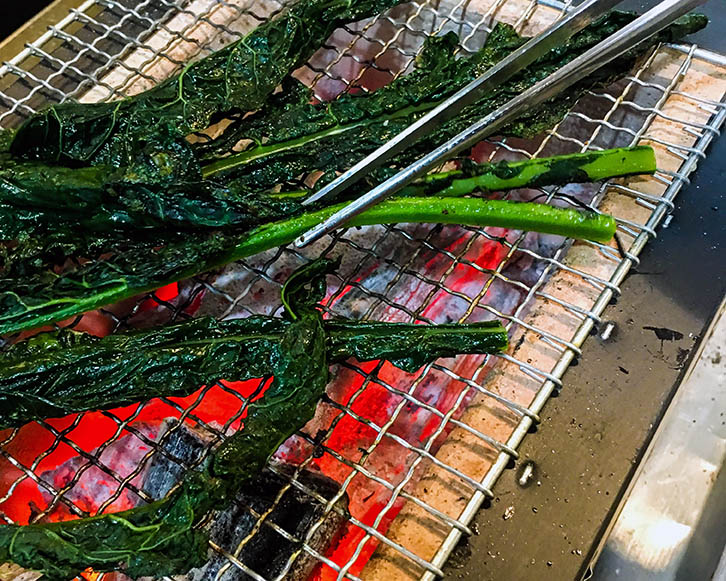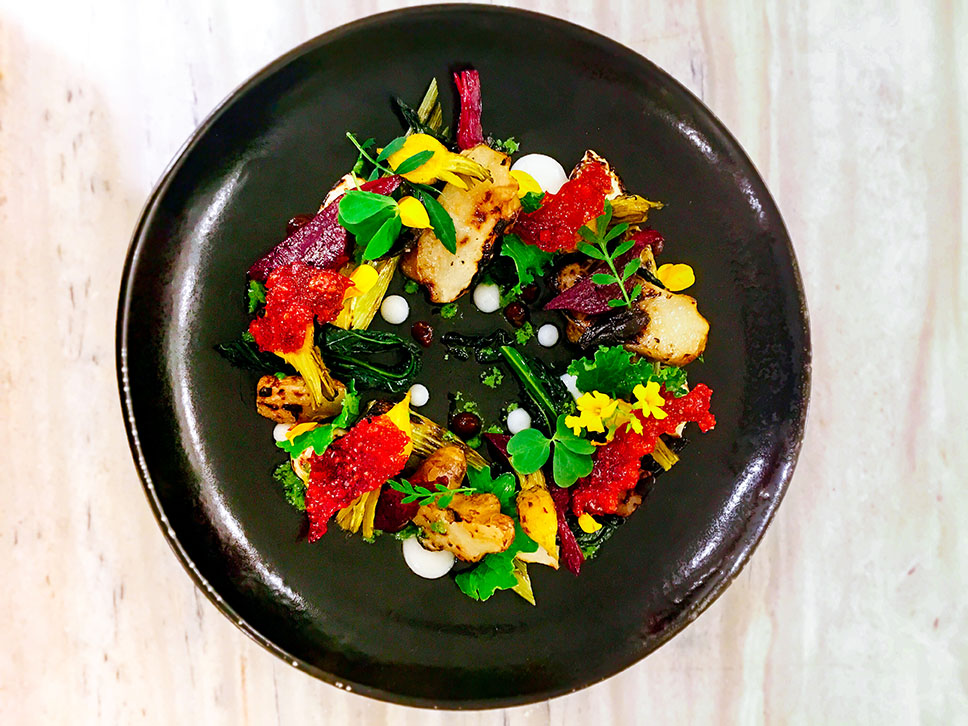It has become fairly common to find a sturdy rectangle box in the kitchens of your favorite restaurants, with chefs occasionally fanning the odd-looking contraption and peering cautiously into the void. Inside this little gem is a true treasure and a chef’s pleasure.
With searing heat between 1,000 F and 1,600 F, no odor and little smoke, Binchōtan charcoal provides chefs with a stable, high heat source and very little to compromise the chosen grilling component. Binchōtan is the name for a number of types of Japanese charcoal. Inside the ceramic Konro Grill, the charcoal burns white hot and maintains its temperature for a number of hours with little need for attention.
There’s a variety of charcoal available under the Binchōtan umbrella; I am using Kishu White charcoal, which has an incredible burning time of around five hours. I want to explore this charcoal to create a simple and delicious vegetarian dish to show natural flavor enhanced by the searing heat of the grill. The end product will be exactly that, both simple and delicious, but navigating an excellent method for this dish calls for some more complex preparations.

After a few tests on the grill with various vegetables, I attempt to make sure I am achieving maximum flavor. I begin by preparing various baby vegetables: baby beets (red and golden), baby turnips, cavolo nero, sunchoke and baby fennel. Each vegetable is trimmed and peeled. The remaining trim from each one is then juiced. I gently heat the vegetable juices to remove any impurities and pigment, which separate when heat is added, then drain through a chinois with cheesecloth to provide a clear vegetable broth. Each juice is then seasoned with sea salt and the vegetables are placed inside a small vacuum pouch with their own juices and sealed.
I cook these pouches in a water bath at varying temperatures to allow the vegetables to cook gently in their own flavor profile until just tender. Cooking the vegetables in their own juice allows for maximum flavor penetration. Using the sous vide vacuum preparation, the vegetables are essentially marinating in their own flavor.
- Baby beets: 90 minutes at 172 F
- Baby turnips: 60 minutes at 172 F
- Sunchoke: 70 minutes at 190 F
- Baby fennel: 100 minutes at 180 F
- Cavolo Nero: Blanch in salted water for 60 seconds and refresh.
Each pouch is then quickly cooled in an ice bath and drained. I re-season the vegetables with a little sea salt and coat in grape seed oil, which has a clean and light taste and a high smoke point of 421 F. This allows the oil to become a great vehicle for the vegetables to char nicely without adding a bitter taste to the final dish.
Now onto the grill for a light charring: the heat blistering the flesh causes an outrageous flavor.
For acidity in this dish, I create a light cultured buttermilk gel and a sweet and tangy raisin purée, which has been steeped in fresh apple juice and compressed in a vacuum chamber. Acidity is needed to lift the dish in the same way a salad dressing works with bitter leaves. Buttermilk allows for acidity and creaminess at the same time. This paired with the sweet raisin and apple gel, works wonderfully to round out the flavors of the dish.
For a beautiful herbaceous flavor to bring everything together, I make an emulsion of sorrel and grapeseed oil. For an element of crunch, I make a beet crisp using tapioca pearls and beetroot juice, simply simmered together until thick and then spread thin on Silpat mats and dehydrated. Once crisp, I fry shards of beet until puffed and crispy.
The final element is a real favorite of mine: grilled black garlic, lightly toasted on top of the charcoal arousing a fantastic deep and rich flavor. I plate with some marigold leaves and flowers, some sorrel and some mustard greens all from our hydroponic farm at ICE.

I find the flavor coming through in this dish to be remarkable. Mixing the complex preparation of the vegetables and the simple charring from this fantastic charcoal, you are left with a nutty, sweet, smoky flavor profile, which is only assisted by the raisin, buttermilk and sorrel pushing through.
These tiny vegetables make a big impact and I certainly have my work cut out as I explore this wonderful Konro Grill and fantastic charcoal product.
Work on research with Chef Barry in ICE's Culinary Arts program and read more about his favorite fall vegetables on DICED.




